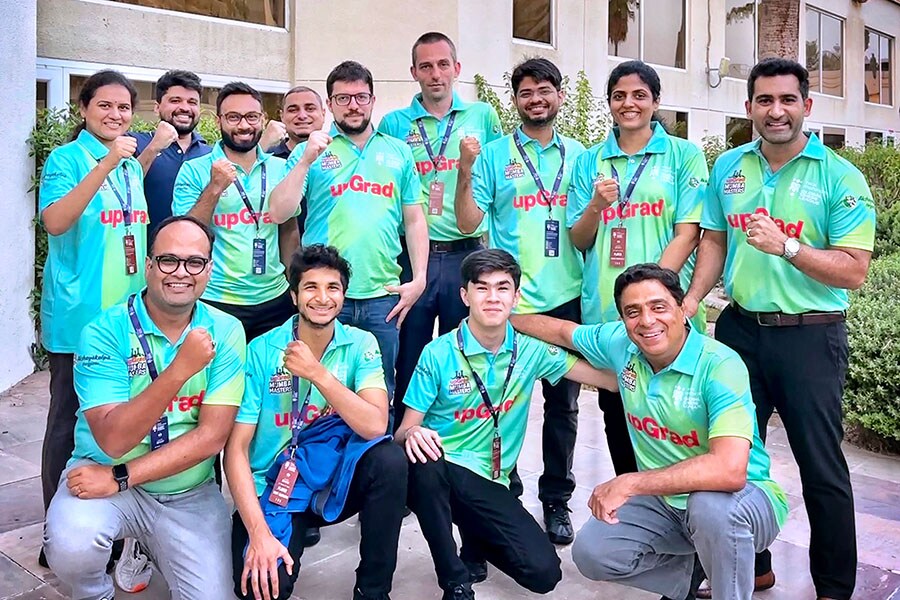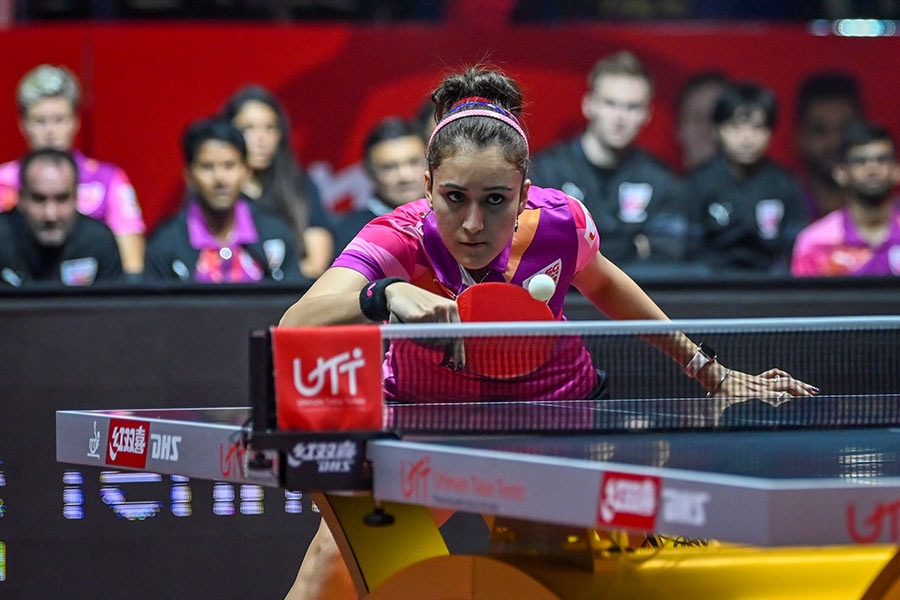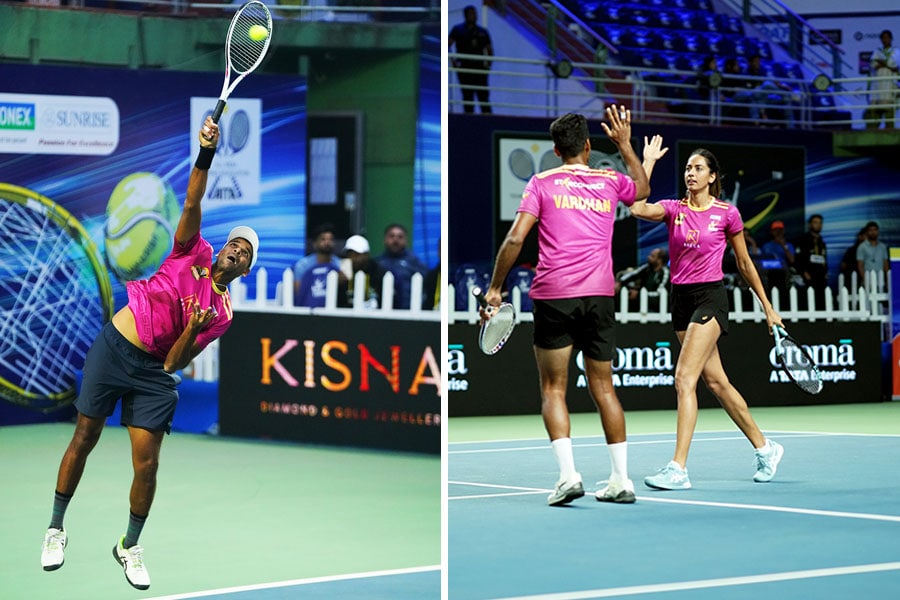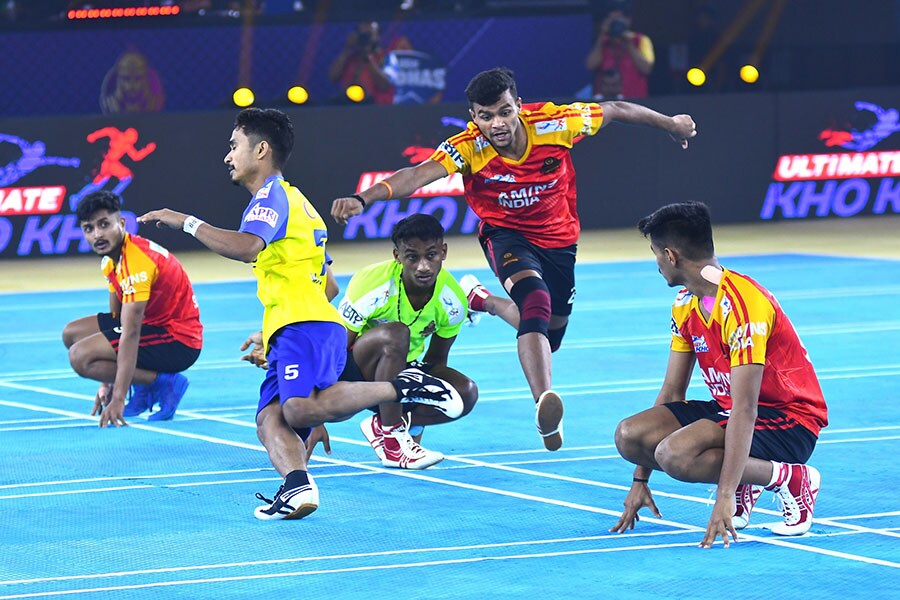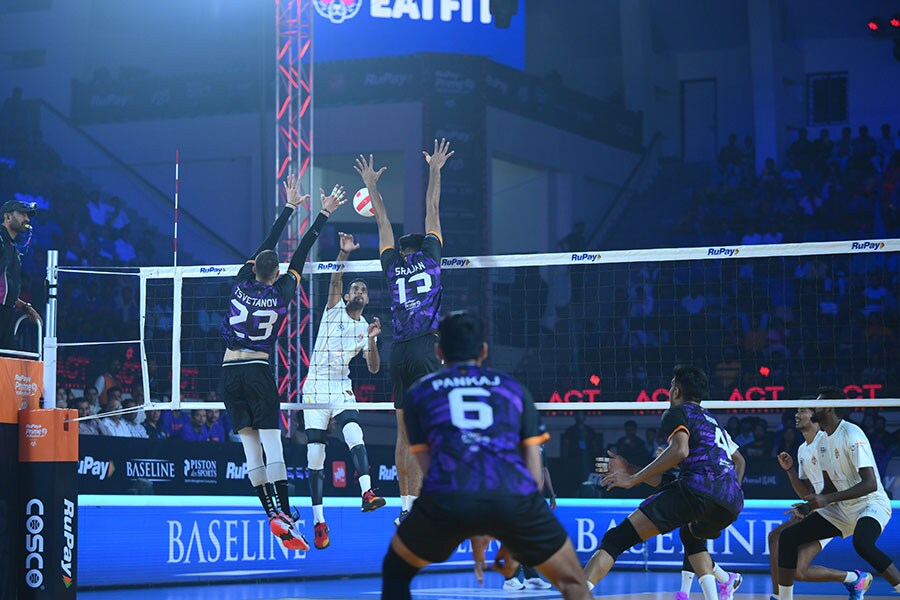Back then, Suhail Chandhok, a former cricketer, was working with Star. “I put my hands up and said I’d like to commentate for this," says Chandhok. “I hadn’t done commentary ever and, at that point, I didn’t even remember how many players were on either side of a kabaddi team. But I saw it as an opportunity to get my foot in the door as a commentator."
It’s a punt that has not only paid off handsomely for Chandhok, now among the most accomplished sports presenters, but also for Star, which also owns 74 percent equity stake on Mashal Sports, the league organisers. PKL is set to enter its 10th season and remains the second-most watched domestic franchise league after the Indian Premier League (IPL). According to data from the Broadcast Audience Research Council (BARC), the tournament registered 222 million viewers in 2022, second only to 361 million for IPL.
It’s not just PKL. Over the last decade and a half, the sports league ecosystem has exploded in India. A hockey league launched in 2005 was considered to be the first of its kind, kickstarting the franchise sports movement in India. While it folded up soon, it was the IPL, which began in 2008, that really stoked the fire, setting the template for growth with skyrocketing valuations expected to touch $10 billion this year.
A number of domestic franchise leagues has mushroomed since, totalling about 15 off the top of the head, encompassing not only sports like badminton and table tennis that have seen success in international tournaments, but also those considered unfashionable, like kho kho or arm wrestling, or under the radar, like volleyball and handball. Even chess, usually a sport associated more with intellect and less with glitz, recently launched the first edition of the Global Chess League (GCL)—a six-franchise rapid chess tournament with high-profile grandmasters like Viswanathan Anand, Magnus Carlsen and Ian Nepomniachtchi.
![]() The upGrad Mumba Masters team that became the runners-up in the inaugural Global Chess League, with UMumba CEO Suhail Chandhok (standing, right) and owner Ronnie Screwvala (sitting, right) Image: Courtesy Global Chess League
The upGrad Mumba Masters team that became the runners-up in the inaugural Global Chess League, with UMumba CEO Suhail Chandhok (standing, right) and owner Ronnie Screwvala (sitting, right) Image: Courtesy Global Chess League
“At the end of the 2020 Chess Olympiad, Anand Mahindra expressed an interest in chess. We thought it may be a novel idea to create a team event with franchisees. To make the format interesting, interactive and also a shorter time control, FIDE, the governing body, Mr Mahindra and myself thought that a league with a more dynamic point system may be a good way to get the game in new media spaces," says Viswanathan Anand, India’s first grandmaster. “We are hoping to get a new demographic for chess and grow on the popularity it has been seeing after the pandemic."
Sports As A Career Option
Why does India have a glut of sports leagues? Because they offer a platform for bottom-of-the-pyramid players to raise their game, by giving them exposure to better players. Like the IPL ecosystem has fostered enough Indian players to draw up format-specific international squads, and give the national selectors a happy crisis of affluence. In effect, a professional league widens the pool of quality players.
![]() Star Indian paddler Manika Batra in action during season 3 of Ultimate Table Tennis Image: Courtesy Ultimate Table Tennis
Star Indian paddler Manika Batra in action during season 3 of Ultimate Table Tennis Image: Courtesy Ultimate Table Tennis
Says Vita Dani, a sports entrepreneur and the co-promoter of Ultimate Table Tennis (UTT), “One of the foreign TT players has narrated to me how they would earlier breathe a sigh of relief if they had an Indian player in the draw, as it was expected to be an easy match. Now, they are alarmed. This explains what franchise leagues like UTT have been able to achieve." In 2017, Dani, also a promoter of the Elms Foundation that focuses on improving sports at the grassroots, and Niraj Bajaj of the Bajaj Group signed a 10-year agreement with the Table Tennis Federation of India to invest Rs 100 crore of their personal wealth over 10 years to not only organise UTT but also tournaments at multiple tiers that would act as feeders to the top level.
A critical factor that moves the needle for sporting leagues is the way they open up earning avenues for professionals, turning sports into viable career options. Chandhok recalls his visit to Rindhana a few years ago, a village in Haryana that’s home to star kabaddi player Pardeep Narwal, who was bought by UP Yoddhas for Rs 1.65 crore in the last PKL auction. “Local kabaddi players in Rindhana and other small towns across India are moving away from family professions of farming or daily labour to take up the sport professionally because a Narwal has shown that you can be a crorepati by playing kabaddi. Players of the grassroots Yuva Kabaddi league, which I launched through my startup Elev8, are earning a steady stream of income. This is empowerment through sport," says Chandhok, also the CEO of entrepreneur Ronnie Screwvala’s UMumba, which owns a franchise each in PKL (for $185,000), GCL ($250,000) and UTT ($150,000).
Even in its early days, the Matrix Fight Night (MFN), India’s premier professional mixed martial arts (MMA) promotion founded by the mother-daughter duo of Ayesha and Krishna Shroff, offered paycheques to fighters that were unheard of in India. “We started small in 2019, but even back then we’d give an MMA fighter $2,000 to show and $1,000 to win, compared to the $200-300 they would make per fight. Our highest paycheques currently are $10,000 to show and $5,000 to win," says Ayesha, co-founder and president.
![]() The Tennis Premier League has become a platform for aspiring young players to earn a fixed income and fund their tennis journey Image: Courtesy Tennis Premier League
The Tennis Premier League has become a platform for aspiring young players to earn a fixed income and fund their tennis journey Image: Courtesy Tennis Premier League
Similarly, the Tennis Premier League (TPL), which was co-founded in 2018 by Kunal Thakkur and Mrunal Jain, picks up kids through Talent Day, its grassroots development programme, for Rs 25,000-30,000, ropes in under-18 players for Rs 50,000 and the top national-level players for Rs 6-7 lakh, with a 20 percent increase every year. “Tennis is an expensive sport and, through the TPL, we are looking to give the players an earning platform," says Thakkur, a former player himself. That apart, the TPL also gives players visibility to brands, he adds. For instance, Ankita Raina, India’s No 1 women’s player, landed herself a three-year endorsement with the Pune-based Punit Balan Group. "When brands come in for the league, they watch the players closely as well," adds Jain.
TPL was the first league that Balan had invested in two years ago, with the Pune Jaguars franchise. Ever since, he has bought seven more franchises across leagues that span from handball to chess and arm wrestling to badminton, allocating over Rs 100 crore in franchise fees and operational costs over five years. Only one of his teams is in a cricket league—the Kolhapur Tuskers in the Maharashtra Premier League—considered the frontline investment sport in India.
Why would a sports entrepreneur put his money in sports that don’t attract big returns or eyeballs? Says Balan, “Investing in sports has a long gestation period for returns, and even the IPL started as a loss-making venture for the team owners before media rights turned things around. The idea is to create an impact and offer support to players so that they can bring medals for the country."
Thakkur of TPL also emphasises a league’s ability to go beyond metros and tier 1 cities and prise open talent pools. In the first season of the TPL, he says, only 140 aspirants had turned out for its Talent Day in Mumbai in season 4 that took place in 2022, 4,800 kids across multiple cities lined up. It has encouraged the organisers to scale up scouting for the upcoming season through 600-odd pan-India tournaments. “We want to reach out to the multiple tennis academies that have come up in places like Nanded, Kolhapur and Solapur," says Thakkur. “Tennis has a greater market penetration and an audience now."
![]() Ultimate Kho Kho, the first edition of India"s first professional franchise league for the sport, has brought forth the interest and the enthusiasm in kho kho that existed beyond the metros and Tier 1 cities Image: Courtesy Ultimate Kho Kho
Ultimate Kho Kho, the first edition of India"s first professional franchise league for the sport, has brought forth the interest and the enthusiasm in kho kho that existed beyond the metros and Tier 1 cities Image: Courtesy Ultimate Kho Kho
Tenzing Niyogi, the CEO of Ultimate Kho Kho (UKK), has a similar story to tell. A few years ago, Niyogi landed up in Maharashtra’s Ichalkaranji and caught glimpses of a kho kho match. Much as the sport wasn’t frontline or top of the mind in urban centres, he realised tier 2, 3 and 4 “were absolutely buzzed with kho kho". “There were 20 lakh+ athletes, all government schools were playing kho kho, most women were playing kho kho. It had a huge following in South India Maharashtra was one of the biggest markets with three state associations and Mumbai alone had 700+ clubs playing kho kho," says Niyogi.
In 2018, he took the blueprint of a professional league to Dabur’s Amit Burman and forged a deal between him and the national federation through which Kho Kho Sports Pvt Ltd was handed over the rights for 20 years. “Burman had earmarked Rs 200 crore for three-four years, of which over 25 percent has been spent to build the product," says Niyogi. “We launched the first season in 2022, and I already have 10-12 potential investors."
![]()
What Makes A League Tick
Not all leagues, though, enjoy such scale of growth. The Premier Hockey League that was launched a good three years before the IPL didn’t manage to attract viewers and shut shop. So did the Cue Slam that was launched in 2016 by the Billiards and Snooker Federation of India along with SportzLive Entertainment. The Hockey India League (HIL) was shelved in 2017 due to financial hurdles and its inability to find a window in the international calendar, but plans are afoot to revive it in 2024 with a jazzier 2.0 avatar. The Pro Wrestling League and the Boxing League, too, have wrapped up their first coming and are looking to start afresh.
“The Hockey India League 1.0 got many things right and had a huge role to play in India’s podium finish in Tokyo," says Dilip Tirkey, president, Hockey India, and chairman, HIL. “What we are doing differently this time is to undertake a sustained campaign to reposition hockey, make it more aspirational and commercially attractive and build a robust financial framework."
What makes sports leagues work? “For one, team sports lend themselves better to leagues than individual ones," says Joy Bhattacharjya, CEO of the Prime Volleyball League (PVL), which is promoted by sports marketing company Baseline Ventures. “For individual sports, we follow players and not franchises. We would watch the badminton league for a [PV] Sindhu-Saina [Nehwal] encounter, but how many of us really remember which franchises they played for?" “This apart," he adds, “a key factor is whether a sport is fit for TV viewing. A sports league must look good on TV."
For it to be packaged into a sleek TV show, a sport has to be fast-paced, offer spectacular visuals, yet remain uncomplicated in its understanding. “Kho kho was replete with eye-catching aerial actions, yet it was a simple sport to follow. The fanfare of a sport is directly related to its simplicity," says Niyogi of UKK.
To make kho kho fit for broadcast, the UKK organisers incorporated a few hygienic changes. For example, the game that is usually played with nine players in a team was brought down to seven. “No stadium in India was high enough to accommodate top view camera angles that would capture all nine," says Niyogi.
The TPL, which is trying to shape an individual sport like tennis into a team game, tweaked the rules to make matches shorter: Each match was broken up into four 20-point games, instead of the usual best-of-three and best-of-five. “Let’s face it," says Thakkur, “no one wants to watch a three-hour match unless you have a [Roger] Federer, [Rafael] Nadal, or [Novak] Djokovic playing."
![]() The Prime Volleyball League has tweaked the rules to make the matches shorter and more exciting, thereby making a sleek package for TV viewing Image: Courtesy Prime Volleyball League
The Prime Volleyball League has tweaked the rules to make the matches shorter and more exciting, thereby making a sleek package for TV viewing Image: Courtesy Prime Volleyball League
Volleyball matches in PVL, too, were converted into sets of 15 points, instead of 25, and included super points that allowed a team to double their points. “We see kids using these rules to play the game now. It shows how deep PVL has gone," says Bhattacharjya of the league that started its journey as the Pro Volleyball League in 2019 before morphing into its current avatar in the aftermath of a bitter rights battle with the national federation. (PVL now bypasses the national apex body and has a direct connect with international parent FIVB.) Its broadcaster Sony says PVL"s first season started with nine advertisers, "which is unique, and the brands continued their association in the second season due to the great ROI", says Rajesh Kaul, chief revenue officer-distribution and international business, and head-sports business, Sony Pictures Networks India. The ripple-down impact of the success of the league can be seen in the Brahmaputra Volleyball League, a grassroots tournament started in Assam in 2020 by Abhijeet Bhattacharya, a former national captain, which grew from 50 teams in the first season to 209 in the second.
Adds Kaul: "The most important factor that we look for in a league is whether the sport has a mass following. It also adds to the value if it is played in other countries. We also look for sports that have a rich heritage of superstars. That apart, something like the Pro Panja league has a cultural significance as the genesis of fist-fighting happened in India."
For the hugely successful kabaddi league, the key was to present to the audience the world’s best level of the sport, says Anupam Goswami, the league commissioner. And as a commitment to that, he adds, “we have systematically incubated the next generation of talent". “It means Pro Kabaddi’s basket of hero athletes are never jaded or stale," says Goswami. “The League directly led the talent development programme in the initial years, and now franchises like Puneri Paltan and UP Yoddhas have picked up the baton."
A consistent pipeline of quality players ensures that a league remains coveted for sports marketers as well. “As a marketer, it’s not difficult to sell a well-planned league as we have seen each sport develop or, at times, discover its own niche market. But it is imperative that non-cricket leagues grow their following not only through social media but also create marketable heroes within the game," says Joshey John, director and sales head, ITW Consulting. “Look at cricket, whose growth has banked heavily on iconic players like Sachin Tendulkar, Mahendra Singh Dhoni or Virat Kohli."
Money Matters
But even if a league has the star factor to boast, it has to establish financial sustainability over the long term. Unlike IPL, which was valued at $8.4 billion in 2022 with a 2x year-on-year growth, not every league can crack a healthy financial code. A prime example would be the Mahesh Bhupathi-led International Tennis Premier League (ITPL), which brought the likes of Nadal, Federer and Serena Williams to play in India, but saw whopping cost overruns that brought it to a closure. According to media reports, Bhupathi, a multi-Grand Slam winner in doubles, had admitted that he owed $5 million to players and vendors.
“Except for cricket and kabaddi, to a certain extent, most new leagues face commercial challenges. However, we do see an increasing revenue path in all sports, especially those that have a large followings, like badminton, football, kabaddi, and volleyball. Non-cricket sports help advertisers and broadcasters generate a greater impact with high degrees of fan engagement, especially for smaller brands who can’t afford cricket," says Atul Pande, the chairman of SportzLive, which has operated the Premier Badminton League for five seasons.
Start small and stay lean, say league promoters. Kho Kho"s first season was a one-venue affair in Pune to reduce production costs, TPL restricted itself to a Mumbai-only model in its opening season, while Matrix Fight Night covered the costs of its first four events only through barter deals. "It was only during the fifth event that sponsors approached us with direct funding," says Ayesha Shroff.
![]()
This is where the quality of promoters, backers and even team owners are put to test, something that even sports entrepreneurs look at before choosing to invest. Chandhok says his father-in-law Ronnie Screwvala, whose first sports investment was in Pro Kabaddi, took much comfort from the fact that it had Mahindra as its promoter. “As a former cricket player and a commentator, I have interacted closely with multiple team owners and CEOs from IPL, PKL or ISL," adds Chandhok. “Despite the intense rivalry on the field, the stronger league owners unhesitatingly come together to work towards improving the product." PVL, on the other hand, follows the NBA model of ownership in which the team owners also own a stake in the league, giving them skin in the game.
The other thing that the IPL has set a template for is how to leverage media rights, which gives sports leagues its biggest revenue share. Consider that in 2008, when the tournament was launched, the BCCI had sold the rights for Rs 8,200 crore for 10 years, while, in the latest auction, the cricket board raked in Rs 48,390 crore for a five-year cycle. “Media rights should stay with the league and be auctioned every few years," says Niyogi of UKK. “It’s the key earnings for a league as other sources—franchise fees and sponsorship—would never match up to it."
The outlier in this regard is Pro Kabaddi, where Star India, the broadcaster, is also an equity rights holder. The debate over whether it’s a good thing came to the fore during the rights auction in 2021 that saw Star as the sole bidder, and winning the rights for Rs 905 crore, just a tad above the base price set at Rs 900 crore. “The model has its advantages—Star came in at a time no one else was invested in the league—but it also limits value," says Chandhok. “I think that will change now as team owners have been very particular about this aspect and we’re seeing the impact of digital and TV as separate assets, as the last IPL auction has shown."
![]()
As You Build, So You Reap
If there isn’t a ready market for a sport, like cricket, football or badminton, new sports entrepreneurs are putting in the hard yards to build the market before rolling out the first season. Take the Pro Panja League, set to begin on July 28, looking to showcase what is hardly recognised as a professional sport in India—arm wrestling. The founders of the league, hence, built up the buzz over the past three-four years through tournaments in front of significant landmarks like the Gateway of India, on top of a casino boat, in front of Gwalior Fort, what have you. “You have to develop a sport," says Parvin Dabas, actor and co-founder of the Pro Panja League. “It is not a three-day opening nowadays. It’s more like OTT—you put it out there and people get to watch it."
The tournaments that they have conducted before have already scored 260 million views of social media, claims Dabas. At small- and medium-scale events conducted in places like Bhind and Bhopal (Madhya Pradesh), Hoshiarpur (Punjab) etc, over 400 players have joined in, while the number in the nationals goes up to 1,300. Dabas hopes to convert this into TV viewership. “We are investing around Rs 20 crore for the first two years, and will be breaking even by the fourth season," he says.
![]()
Most of the league promoters and team owners have reconciled with the fact that a sports league investment involves patient capital. "Any sports IP needs at least a minimum of five years to break through the mass audience," says Jain of TPL. The priority is to build up an ecosystem before pursuing profits. And the results are showing. Sponsorship revenues for PVL almost covered its entire expenses in the first season and the league itself is very close to breaking even after season 2 season 5 of the TPL to be held in December 2023 is expected to bring in a 50 percent rise in sponsorship revenue, while the number of business categories for sponsoring teams in the kabaddi league has increased from 14 in season 8 to 17 in season 9.
Sponsors also look at the bigger picture while joining the fray, instead of an immediate attempt to move the marketing needle. Tech Mahindra, the title sponsor for the chess league, feels the rollout of the league of such a global scale will attract bigger corporate attention in future, enabling newer investors to enter the field. Says Jagdish Mitra, chairperson, Global Chess League Board and chief strategy officer and head of growth, Tech Mahindra, “We want to make sure the existing 600 million fan base of chess grows further to a billion. The plan is to expand to eight teams by season 3 and to 10 teams by season 5, from the current six."
Balan of the Punit Balan Group, which houses eight franchises, explains the efficacy of slow growth through the sponsorships for his kho kho team: In season 1, the front-of-jersey title sponsorship for his team, Mumbai Khiladis, went for around Rs 35 lakh Balan has already bagged Rs 1 crore for it this year. “We are in this for the long term and the valuations will only rise," he says. Ayesha and Krishna Shroff of MFN say they were chasing and closing sponsorship deals even the day before the first edition of the fight night, while for the 12th edition that took place in Noida on July 1, “we’ve closed sponsors 15 days earlier than we normally do".
Says Ayesha: “When the Ultimate Fighting Championship started out in the US 30 years ago, they were valued at $250,000. They were literally surviving show to show, just as we have been doing. Today, they are a $14 billion company. While we do have a long way to go to get to those numbers, the future is good."

